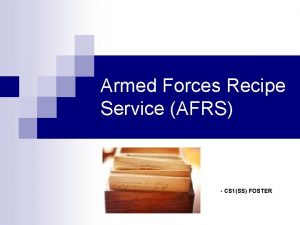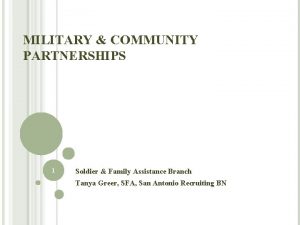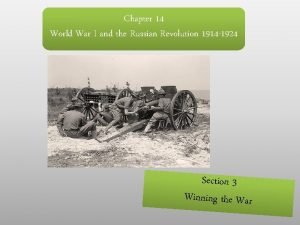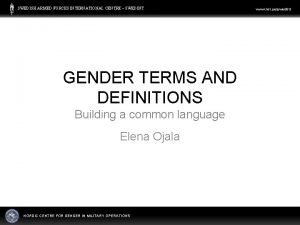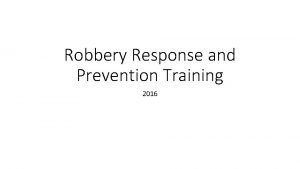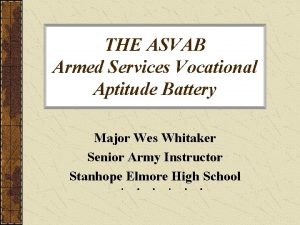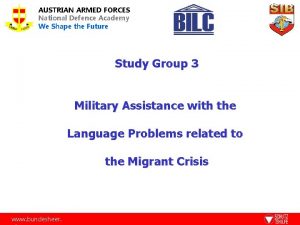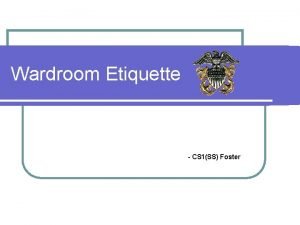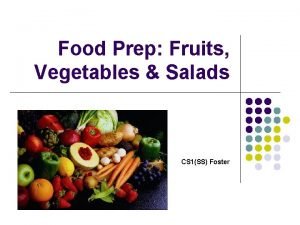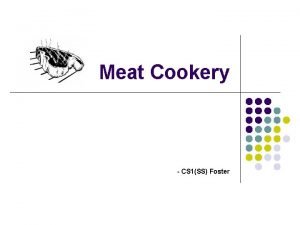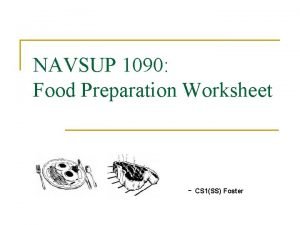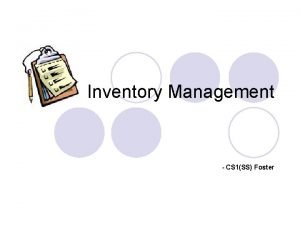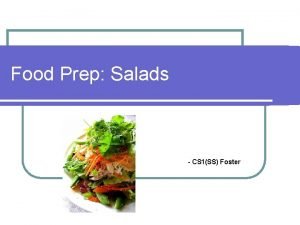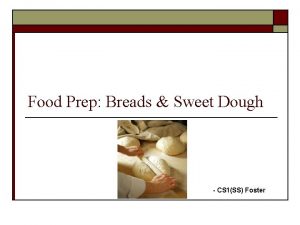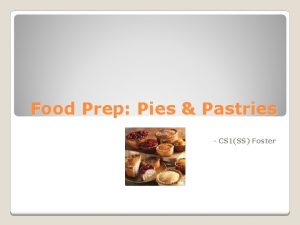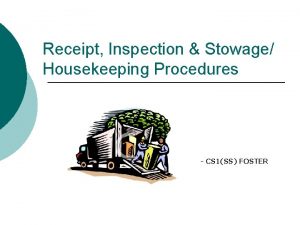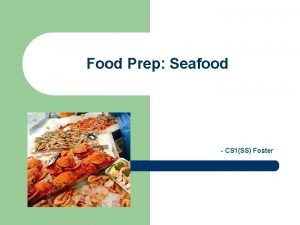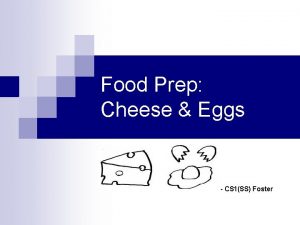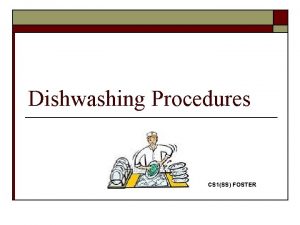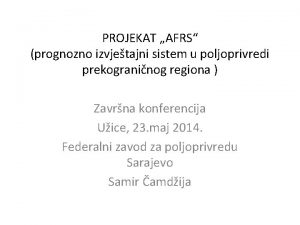Armed Forces Recipe Service AFRS CS 1SS FOSTER






















- Slides: 22

Armed Forces Recipe Service (AFRS) - CS 1(SS) FOSTER

Learning Objectives Explore the components of the AFRS n Understand it’s use n Explain Recipe Conversions n

AFRS n n The Armed Forces Recipe Service is a grouping of standardized recipes and supplemental information The groupings are by letter designators (which you should memorize – testable) Each lettered section contains a index at the beginning as well as guideline cards specific to that section All recipe cards contain their own information so it is very, very important to always READ the card prior to beginning preparation

Recipe Cards

Recipe Cards n n n One of the most important things to note about Navy recipes, is they are all standardized at 100 portions This allows for easier recipe conversions, which we will cover later They also list nutritional information, portion size, ingredients by name, weight, measure and a detailed method of preparation The method is often the most important part of the recipe; following it in detail can be the difference between a correct and unsuitable end product Also, within the method you with find Critical Control Points (CCPs), which are HACCP references such as: “Hold for service at 135°F or higher”.

Recipe Card Designators n n n n n A – General Information/Guidelines B – Appetizers C – Beverages D – Breads & Sweet Doughs E – Cereals & Pastas F – Cheese & Eggs G – Dessert: Cakes & Frostings H - Dessert: Cookies I - Dessert: Pastries & Pies J - Dessert: Puddings & Other Desserts K - Dessert: Sauces & Toppings L – Meat, Fish & Poultry M – Salads, Salad Dressings & Relishes N – Sandwiches O – Sauces, Gravies & Dressings P – Soups Q - Vegetables

Index

Index n n n The recipe index at the beginning of each section is much like the card catalog at a library It helps skip through large sections to get to where you want to be, helping locate your desired recipe If available, the online version is much easier in the format of a search engine: https: //nll 1. ahf. nmci. navy. mil/recipe/

Guidelines n n Guideline cards are useful tools for either a certain subject of to a specific category of recipes They are found at the beginning of the AFRS, in the section labeled “A”. These are general cards that are usually references on a technique, procedure or measurement equivalents The guidelines within a section, such as meats, would be L-G cards that are specific guidelines for a type of meat preparation

Guidelines (“A” type)

Guidelines (“G” type)

Measurements n n n It’s extremely important to understand all the different measurements, and their equivalents This information is invaluable to your correctly converting recipes to the number of desired portions and actually measuring the ingredients after that This is also TESTABLE! You will see these questions on every exam until you’re in khakis, so memorize it!

Measurements n n n n 3 tsp. 2 tbsp. 8 fl oz. 2 cups 2 pints 4 quarts = = = 16 oz. 1 pt. (water) 1 tbsp. 1 fl. oz. 1 cup 1 pint 1 quart 1 gallon = = 1 pound

Recipe Conversions n Ø Ø - This leads into the 3 types of conversions: Yield Adjustment This conversion is simply the conversion of the standard 100 portion yield into a desired portion yield Quantity Adjustment This is the conversion of one of the standard quantities to a different quantity, as in the use of more or less of a certain ingredient without adjusting the yield Portion Size Adjustment This adjusts the recipe to accommodate a larger or smaller portion size than is given on the card.

Yield Adjustment Ø Working Factor (WF): the number you need to convert ingredients to desired quantities. So if I were to tell you I want you to prepare 379 portions of Meat Sauce, your WF would be reached like this: DESIRED 379 ÷ ÷ GIVEN = WF 100 = 3. 79

Yield Adjustment n Then you simply multiply ingredients by your WF. So if there is 30 lbs. ground beef per 100 portions on the recipe, then: 30 lbs. n x 3. 79 = 113. 7 lbs g. beef The same concept is behind all conversions, just different ways of reaching the WF.

Quantity Adjustment n n Just remember one formula, DESIRED ÷ GIVEN = WF. So even though your using different numbers, it’s always the same formula. If a recipe says you need 30 lbs. per 100 p of ground beef, and CSC says “use 45 lbs. ”. Then what do you do? 45 lbs. n ÷ 30 lbs. = 1. 5 Poof! WF! Then just follow the same steps for the rest of the recipe, multiplying WF by the given amounts to get the desired amounts.

Portion Size Adjustment n CSC gives you a portion size of 11 oz but the recipe says 8 oz. What do you do? 11 oz. n ÷ 8 oz. = 1. 38 Look familiar? DESIRED ÷ GIVEN = WF. Every time.

Review n n - How is the AFRS organized? By letter designators What is the designator for Meats? L Pies & Pastries? I Vegetables? Q

Review n n n - Where do you find the General Guidelines section? At the very beginning of the AFRS, section A. What is the standard yield for Navy recipes? 100 portions How many teaspoons in a tablespoon? 3 How many fluid ounces in a quart? 32 How many pints in a gallon? 8

Review n Best way to find your Working Factor? - DESIRED ÷ GIVEN = WF

Questions?
 Army recipe cards
Army recipe cards [email protected]
[email protected] Armed forces military
Armed forces military Armed forces military
Armed forces military Canadian armed forces cook
Canadian armed forces cook Russian armed forces branches
Russian armed forces branches Nordic center for gender in military operations
Nordic center for gender in military operations Armed robbery response training
Armed robbery response training Probably armed possibly not analysis
Probably armed possibly not analysis Remains poem
Remains poem Asvab meaning
Asvab meaning Cross armed opposites
Cross armed opposites The king sits in dumferling toune accent marks
The king sits in dumferling toune accent marks Armed defense academy
Armed defense academy What do you mean by like parallel force system?
What do you mean by like parallel force system? The forces shown above are
The forces shown above are Intermolecular forces from strongest to weakest
Intermolecular forces from strongest to weakest Intermolecular and intramolecular forces
Intermolecular and intramolecular forces Intramolecular forces vs intermolecular forces
Intramolecular forces vs intermolecular forces Contact and noncontact forces
Contact and noncontact forces Net force
Net force What are constructive and destructive forces
What are constructive and destructive forces Forces transforming the service economy
Forces transforming the service economy
